
Are we in a bad way, but are we doing well?
The long list of companies that closed, suspended operations or laid off in the last year
Fresenius Medical Care, Xerox, Clorox, Prudential, Procter & Gamble, Nutrien, ENAP and HSBC, Dánica, Chango Más, Diarco, Copetín Gonzalo, Granja Tres Arroyos, AVON, NRG Argentina, Fabrisur, Whirlpool, Textilcom, AlpaCladd, General Motors, Acindar, Bridgestone, among many others.
More than 2,300 companies closed their doors, while others reduced their production or implemented mass layoffs. From multinationals to SMEs, the impact of the recession affects thousands of workers.
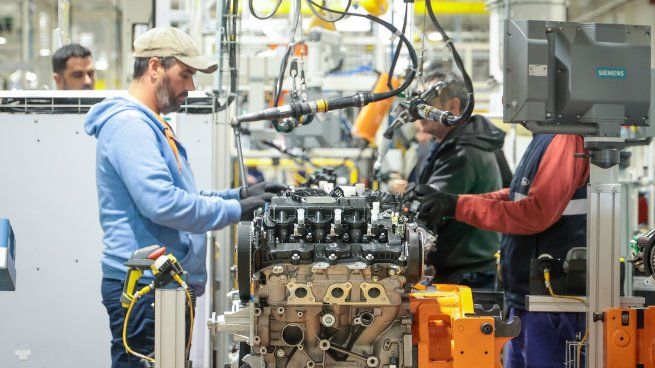
The industry suffered a sharp decline this year and that was evidenced in company closures and mass layoffs.
In the last year, Argentina experienced a notable outflow of multinational companies and a series of closures, production suspensions and layoffs in various industries, reflecting the complex economic situation that the country is going through.
The data are conclusive, according to a report by the Confederation of Industrial Unions of the Argentine Republic (Csira), between November 2023 and August 2024, 38,532 jobs were lost in the industry. If the construction and mining sectors are included, the figure rises to 126,050 jobs lost.
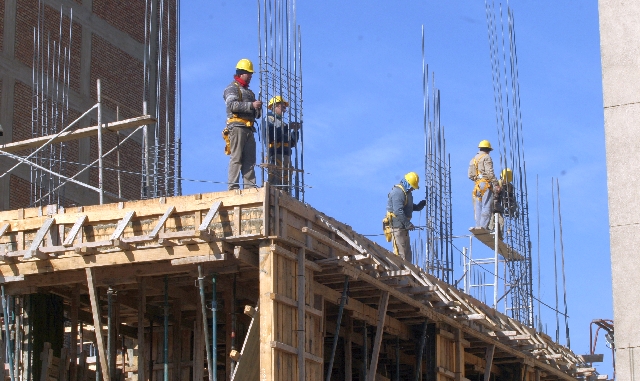
In addition, in the same period, 879 companies closed in the manufacturing industry, and 2,333 if mining and construction are also considered. The situation has led 86.6% of the unions surveyed to consider that activity has worsened since Javier Milei came to power, reflecting a climate of growing concern in the workplace.
The labor outlook was also strongly affected, with 60% of industrial unions reporting layoffs in the last quarter and a third of them pointing to difficulties on the part of companies to pay wages. In addition, 82% of the unions surveyed indicated cuts in overtime, and 72% mentioned suspensions, leaves and early vacations for a percentage of workers.
In this context, in the last year, at least eight multinationals stopped operating in Argentina, including HSBC, Xerox, Clorox, Prudential, Nutrien, ENAP, Fresenius Medical Care and Procter & Gamble.
The truth is that the crisis reached all industries equally and many companies chose to stop their production and/or execute layoffs to stay afloat.
An emblematic case was that of Acindar, the steel company, a subsidiary of ArcelorMitta, suspended production at all its plants for a month in March 2024, due to an abrupt drop in demand. Subsequently, in June 2024, it announced a three-week suspension at its plant in Villa Constitución, Santa Fe, and a reduction of its annual production from 1.2 million tons in 2023 to 600,000 tons in 2024.
More recently, the company announced an "untimely" advance of the stops they had scheduled for the end of the year, "due to the sharp drop in sales," according to the union. This stoppage of activities affects more than 700 workers.
In the same vein, Ferrum, the leading company in the manufacture of toilets, paralyzed its plants and carried out layoffs and suspensions of workers in the first half of 2024, in response to the decrease in activity in the construction sector.
Meanwhile, Textilcom and AlpaCladd, textile companies, which produce for brands such as Cheeky, Mimo, Yagmour and Penguin, laid off 300 workers in May in the provinces of Catamarca and La Rioja, due to falling demand and financial difficulties.
The fall in consumption also affects the appliances or white goods sector, which in turn is being unprotected by the reduction of tariffs on the import of refrigerators and washing machines. This led to layoffs at Whirlpool and Briket, among others. In the first, there were 60 layoffs in the company due to production reduction at its plant in the Pilar Industrial Park, in the province of Buenos Aires, in May of this year. In Briket, located in the south of Rosario, the company – which produces refrigerators, displays and freezers – has laid off 300 workers so far this year.

The list goes on and just to mention two cases, General Motors, made 33 layoffs and agreed to 167 voluntary retirements, within the framework of a reduction in production projection. For its part, Bridgestone, the tire company located in Lomas de Zamora, Buenos Aires province, laid off 35 workers in February 2024, citing a drop in demand.
In the retail segment, the ChangoMás supermarket chain laid off around 200 employees in the province of Buenos Aires in May of this year, as part of an operational restructuring.
Later in time, the firm Dánica announced the closure of its plant located in the town of Lavallol, province of Buenos Aires. The decision, taken by the Beltrán Group, owner of the company since 2018, is part of the company's decrease in demand and economic problems. The measure would leave 150 workers unemployed.
Another historic company that this year declared bankruptcy and fired all its workers is the Mendoza-based Copetín Gonzalo, the firm with 30 years of experience closed its doors definitively in the Milei era.
Also in the food sector, companies such as Granja Tres Arroyos, Bimbo and Pepsico, among many others, this year advanced with dozens of layoffs in their different production plants. In all cases, the fall in demand and the high costs of production and labor were the main causes of the decision.
The reality is that job losses and business closures not only affect the workers directly involved, but also local economies and the value chains of various industries. In this context, for the time being, the projections of job creation for 2025 do not seem to be very encouraging.
González Olguín: "There was a profound economic and social deterioration in a very short time"
The economist and professor at the National University of Córdoba analyzed the results of the economic policy applied by Milei's government one year into his administration.
Economist Eduardo González Olguín said that the government of Javier Milei caused "a deep economic and social deterioration" in just one year.
"I think that with all objectivity it can be affirmed that Milei's economic policy has caused in a very short time a profound economic and social deterioration in Argentina. That can be synthesized in some indicators," said the professor of the National University of Córdoba (UNC), about the result of the economic policy applied in the last 12 months.
Among the most alarming data, González Olguín highlighted "a 3.8% drop in the Gross Domestic Product (GDP) compared to the previous year, according to the International Monetary Fund";the loss of 16% in real wages";the elimination of 261 thousand registered jobs, not counting the informal jobs affected"; "the increase in unemployment that went from 5.7% to 7.6%" or "the closure of 16 thousand SMEs and a drop in sales of small and medium-sized companies of 13.2%".
In addition, he stated that the purchasing power of workers and retirees also fell. "Pensions, which in November 2023 covered half of the basic basket of the elderly, today only reach a third."
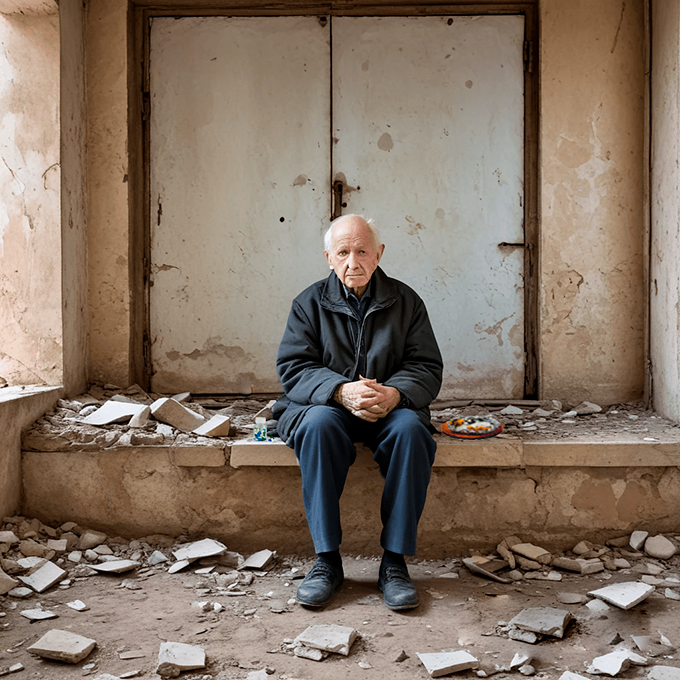
On the other hand, he commented that "poverty went from 41.7% at the end of last year to 55% in the second half of this year, while indigence increased from 11.9% to 15.8%."
He also mentioned that meat consumption reached the lowest level in 26 years and that investment suffered the largest drop since 2004, with a decline of 35%, only comparable to the most critical years of the pandemic. For González Olguín, these figures show "a strong retraction of demand".
Brazil's central bank raises benchmark interest rate to 12.25 pct
BRASILIA, -- The Monetary Policy Committee (Copom) of Brazil's central bank decided on Wednesday to increase the benchmark Selic interest rate from 11.25 percent to 12.25 percent, the second-highest since November 2023, when it stood at 12.75 percent.
In response to an adverse economic scenario complicating the convergence of inflation toward the target, additional adjustments of the same magnitude are expected in the next two meetings, potentially raising the Selic rate to 14.25 percent annually, according to Copom's statement.
"The total magnitude of the monetary tightening cycle will be determined by the firm commitment to inflation convergence toward the target and will depend on the evolution of inflation dynamics, particularly the components most sensitive to economic activity and monetary policy," the statement said.
The interest rate increase aims to curb inflationary pressures, as the Consumer Price Index may exceed the upper limit of the official target range, set at 3 percent with a tolerance of 1.5 percentage points. Analysts project inflation at 4.84 percent for this year.
This decision marks the largest Selic rate hike under the administration of Luiz Inacio Lula da Silva and the most significant increase since February 2022, when a 1.5-percentage-point hike was implemented. All nine Copom members voted unanimously for the adjustment.
Wednesday's meeting was the last led by Roberto Campos Neto, who will step down as central bank president in January 2025. He will be succeeded by Gabriel Galipolo, the current director of monetary policy at the Central Bank, who was appointed by Lula and approved by the Senate in October.

Opposition vows to build a democratic and pluralistic Syria after the fall of al-Assad's government
DAMASCUS, Syria (AP) — The Syrian National Coalition, one of Syria's main oppositions, vowed Sunday to continue working to transfer authority to a transitional governing body with full executive powers, to usher in a free, democratic and pluralistic Syria.
In a statement to the international community, the coalition emphasized its commitment to ensuring stability and security in neighboring countries and stressed that Syrians will refrain from interfering in the affairs of regional states.
The coalition said it hoped to forge strategic alliances with countries in the region and around the world to rebuild Syria for all its citizens, regardless of ethnicity, religion or sect. The group reiterated its vision of a nation founded on equality and democratic principles, laying the foundation for a peaceful and inclusive future.
In recent days, Damascus has become a focal point of rapid developments, marking a critical turning point in Syria's protracted civil conflict. The Syrian capital, which for years remained under the tight control of President Bashar al-Assad's government, experienced a sudden and dramatic change in power on Sunday following major rebel advances in the country.
Beginning in late November, armed opposition groups made significant gains in northern provinces such as Aleppo, where the Hayat Tahrir al-Sham rebel group spearheaded a major offensive against government forces. With the rebels' advance, reports emerged of rapid army withdrawals from major southern provinces, including Quneitra, Daraa, and Sweida.
Inside the capital, these developments sparked public anxiety, and many residents were unsure of what would come next. They rushed to get basic necessities, such as bread and rice.
After opposition forces seized control of Damascus, the Russian Foreign Ministry confirmed in a statement on Sunday that al-Assad has left Syria and resigned as the country's president, who, in the meantime, called for a peaceful transfer of power.
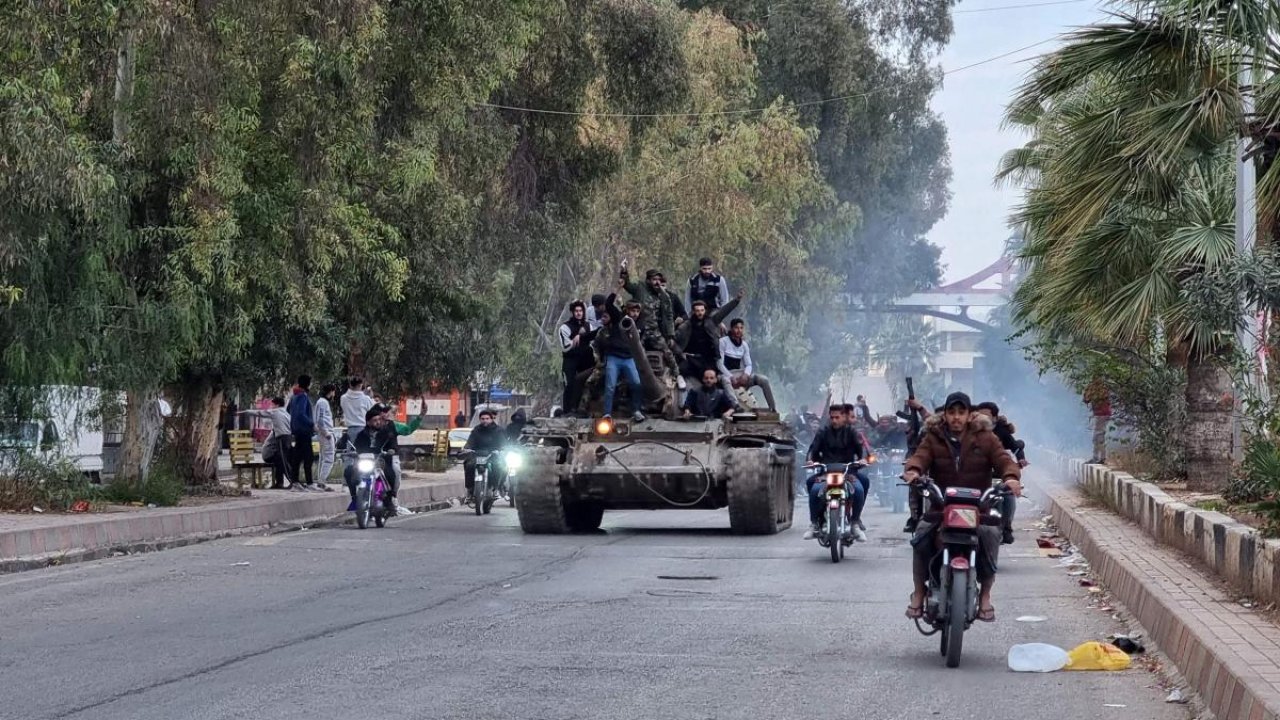
Local factions and international observers are closely monitoring the situation in Syria, concerned about the stability of diplomatic missions and the potential for violence in the Syrian capital following incidents such as the assault on the Iranian embassy.
Iranian Foreign Ministry spokesman Esmaeil Baghaei on Sunday condemned the attack, while noting that Iran's ambassador to Syria and embassy staff were in full health.
Mercosur and the EU announce the completion of trade agreement negotiations in Uruguay
MONTEVIDEO -- Uruguayan President Luis Lacalle Pou and European Commission President Ursula von der Leyen confirmed Friday the completion of negotiations for a trade agreement between the Southern Common Market (Mercosur) and the European Union (EU).
During the 65th Summit of Mercosur (Argentina, Brazil, Paraguay and Uruguay) and Associated States, which is being held this Friday in Montevideo, Lacalle Pou said that an agreement of this nature "is not a solution, it is an opportunity."
Exercising the temporary presidency of Mercosur, the Uruguayan president pointed out that the speed of progress will depend on the will of each country, emphasizing that progress must be made with "small, but sure" steps in the same direction.
Lacalle Pou spoke on behalf of the other founding members of the South American bloc: Javier Milei (Argentina), Luiz Inácio Lula da Silva (Brazil) and Santiago Peña (Paraguay).
For her part, Von der Leyen expressed the "success" of the negotiations, calling them an "ambitious" agreement that sends a "clear and forceful message to the world" by demonstrating that democracies can support each other.
"Today is truly a historic milestone, and let me thank the chief negotiators for their dedication and determination," von der Leyen said.
"This agreement is not just an economic opportunity; It is a political necessity. We are partners with shared mentalities and common roots," he added, speaking at Mercosur headquarters.

Mercosur and the European Union had initially reached an agreement in 2019, but it was never ratified and had to be renegotiated.
The agreement still needs to be ratified by the parties involved, including the parliaments of the four founding countries of Mercosur. However, it faces resistance from some European nations, led by France, who fear that the influx of agricultural products from South American countries could negatively affect their own agricultural sectors.
The agreement would create a market of more than 700 million people, making it the largest free trade area in the world.
Mercosur hopes to export more food products such as beef and soybeans, while the European Union aims to increase shipments of cars and machinery.
Uruguayan Foreign Minister Omar Paganini explained that the agreement allows Mercosur countries to eliminate 70 percent of tariffs on exportable products such as industrial oils, fish, fruits, vegetables and infusions.
For Paganini, the trade pact also opens up opportunities for European investments in Mercosur as part of value chains.
Due to challenges in gaining parliamentary approval in the European Union, the agreement has been split into two parts: a three-pillar Association Agreement and an Interim Trade Agreement as the trade pillar.
The trade agreement will be adopted more quickly than the Association Agreement, as it is the exclusive competence of the European Union and only requires its adoption by the EU institutions and its Parliament.
The Association Agreement, on the other hand, is a mixed competition agreement and must be approved not only by the EU institutions, but also by the national and regional parliaments of each Member State.
Mysterious finding: scientists discovered life forms in ancient rocks more than 3000 years old
These organisms, of surprising sizes, could offer new clues about the evolution of life on Earth.
:format(jpg)/f.elconfidencial.com%2Foriginal%2F384%2Fbb8%2F481%2F384bb848164a39bd4d51cc6d4a9fe397.jpg)
Scientists have made a surprising discovery by finding fossilized cells in rocks that formed shortly after Earth's birth, about 3.8 billion years ago.
These cells, remarkably different from any other living thing on the planet, have no cell walls and present a complexity that exceeds that of modern cells.
Now, a new study offers a new explanation for the origin of these mysterious structures and suggests that they could be the precursors of modern cells.

What are the cells found in ancient rocks like?
Unlike modern bacteria, which are typically 1 to 2 micrometers wide and lack internal structures, the microfossils found in these ancient rocks are a considerable 60 to 70 micrometers in size.
This unprecedented discovery has been a subject of intense debate among biologists, who question whether these fossils really represent the remains of living cells.
An eye-opening study on bacteria
Microfossils were first discovered in 1987 and have since been found in different parts of the planet. "They seem too complex," said Dheeraj Kanaparthi, a researcher at the Max Planck Institute for Biochemistry in Germany, in statements collected by New Scientist.
"They're also too big. What we find is always disconcerting," he added.
The recent study by Kanaparthi's team, still pending publication, focuses on bacteria growing around freshwater springs at the bottom of the Dead Sea.

These organisms are a type of cell without a wall called L-forms, known since the 1930s. It was found that under high salinity conditions, these cells tend to swell and develop structures similar to mysterious microfossils.
How was the evolution of these cells?
The researchers suggest that the saline conditions and the type of salts present in the environment of these primitive fossils could be responsible for the excessive growth of the cells, forming what appear to be internal structures, indicates the article written by Omar Kardoudi.

In different situations, these L-forms grow in long chains that divide into separate cells. "We thought that these cells would grow into big bubbles and then split into a thousand pieces," Kanaparthi explains, adding, "But in reality, they reproduce in a very defined way."
This study provides evidence on:
The country showed its interest in acquiring Scorpene submersibles by signing a letter of intent.
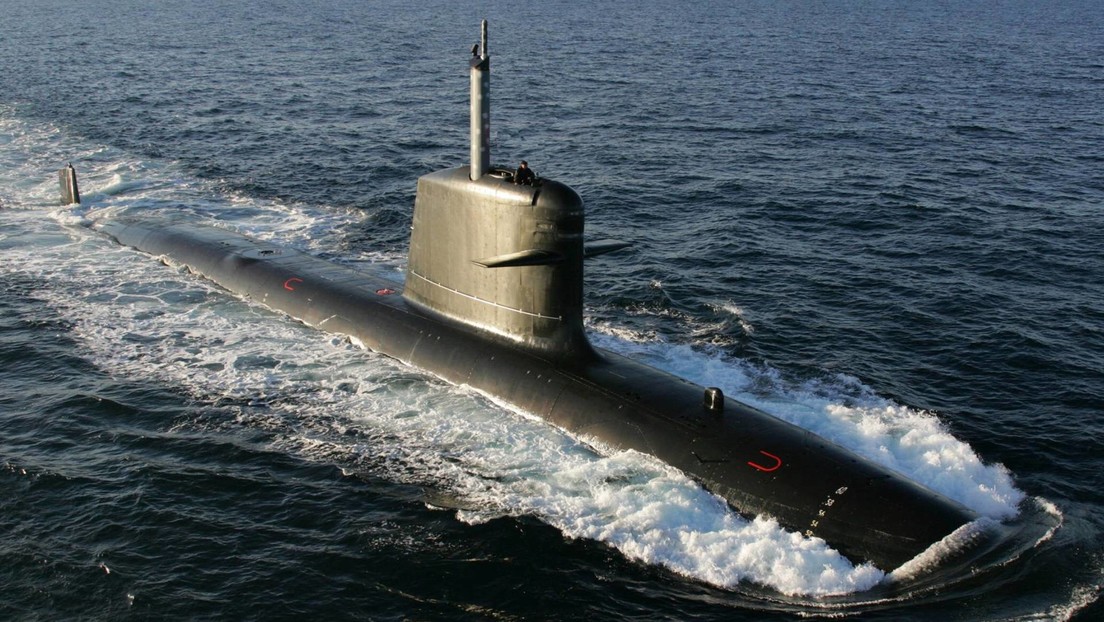
Scorpene submarine made in France.
The government of Argentine President Javier Milei took another step towards its goal of acquiring new submarines for the country's Navy with the aim of recovering an operational capacity of this force after the loss of the submarine ARA San Juan, which sank in 2017, Todo Noticias reported on Sunday.
According to the media, a few weeks ago, Argentina's Ministry of Defense managed to sign a letter of intent with its French counterparts to acquire Scorpene-class units, which means that the Latin American country showed interest in moving forward with an eventual agreement. However, the signing of a letter of intent does not yet mean that the agreement has finally been finalized.
Previously, it was already revealed that in the 2025 Budget the Milei government made a request for debt for some 2,300 million dollars "for the recovery of submarine capacity." The minimum repayment term is three years and the Ministry of Defense would take the loan.
The Argentine government is considering buying two French Scorpene submarines, developed by the company Naval Group, at a unit cost of 500 million dollars. Its construction may take up to seven years and it is not even ruled out that the Argentine shipyard Tandanor will participate in the process.
These submarines, which are 72 meters long, have a diving depth of 300 meters, an autonomy of 78 days to carry out missions in the open sea and a payload of 18 torpedoes and missiles.
MOSCOW -- Russian President Vladimir Putin signed a decree approving Russia's updated nuclear doctrine, the Kremlin reported Tuesday.
The decree, published on the Kremlin website, states that aggression by any state in a military coalition or bloc against Russia or its allies is seen as aggression by the entire bloc as a whole and aggression from a non-nuclear state, with the involvement or support of a nuclear power, will be regarded as a joint attack on Russia.
According to the document, Russia views nuclear weapons "as a means of deterrence ... which is a last-resort and forced measure," and the country is taking "all necessary efforts" to reduce the nuclear threat and prevent the escalation of interstate tensions that could lead to military conflicts, including nuclear ones.

The revised doctrine further clarifies the states and military alliances subject to nuclear deterrence. According to the decree, nuclear deterrence is aimed at potential enemies, which are defined as "individual states and military coalitions that view Russia as a potential enemy" possessing nuclear weapons or significant general-purpose military capabilities.
Nuclear deterrence is also aimed at states that allow their territory and resources to be used for aggression against Russia, the decree added.
BEIJING, (Xinhua) -- New equipment, including the J-35A fighter jet, will debut at the 15th China International Aviation and Aerospace Exhibition, also known as Airshow China, China's Air Force announced on Tuesday.
Apart from the J-35A medium-sized stealth fighter, the HQ-19 surface-to-air missile weapon system and a new attack reconnaissance unmanned aerial vehicle will also be unveiled for the first time at the air show, said Niu Wenbo with the Air Force equipment department at a press conference.
The air show, scheduled for Nov. 12-17 in the southern Chinese city of Zhuhai, features a diverse range of activities including aerobatic displays, according to Air Force spokesperson Xie Peng.
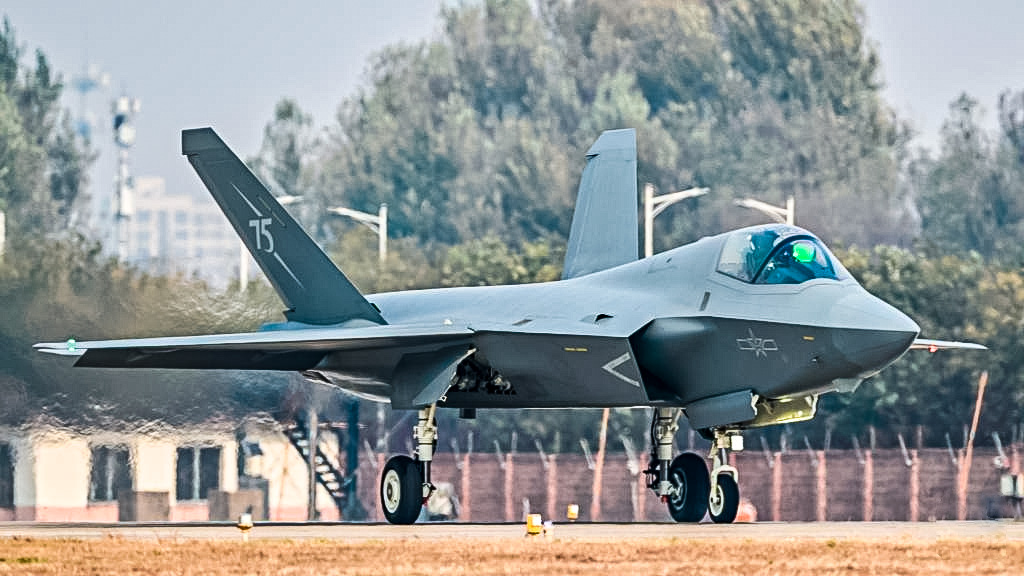
The aircraft set to fly at the show include the J-20, J-16, and the YY-20A for refueling. The cargo hold of Y-20 aircraft will also be open to the public.
The event coincides with the commemoration of the 75th anniversary of the founding of the Chinese People's Liberation Army Air Force, which falls on Nov. 11. ■
To understand what makes a DANA so destructive, it is first necessary to understand what this phenomenon consists of. Depressions, in meteorology, are areas of low atmospheric pressure, which means that the air is denser in the surroundings than in the center of this "bubble." This imbalance of pressures is essential to generate rain, storms and strong winds.
 In the case of a DANA, the situation is even more complex. This phenomenon, which is also known as a "cold drop," occurs when a mass of very cold polar air is isolated at high altitude, between 5,000 and 9,000 meters above sea level. Unlike other storms, the DANA forms in isolation from the air currents that normally regulate the climate in the northern hemisphere, such as the polar jet stream or the subtropical jet stream. This isolation allows the cold air mass to begin to interact with the warm, humid air in its surroundings, generating conditions of atmospheric instability. The orography of the Iberian Peninsula, particularly the arrangement of the mountains in the Valencia region, favors the rise of warm, humid air from the sea into the atmosphere, where it meets the cold air of the DANA. This clash between air masses in different states of temperature and humidity intensifies rainfall and generates extremely unstable conditions.
In the case of a DANA, the situation is even more complex. This phenomenon, which is also known as a "cold drop," occurs when a mass of very cold polar air is isolated at high altitude, between 5,000 and 9,000 meters above sea level. Unlike other storms, the DANA forms in isolation from the air currents that normally regulate the climate in the northern hemisphere, such as the polar jet stream or the subtropical jet stream. This isolation allows the cold air mass to begin to interact with the warm, humid air in its surroundings, generating conditions of atmospheric instability. The orography of the Iberian Peninsula, particularly the arrangement of the mountains in the Valencia region, favors the rise of warm, humid air from the sea into the atmosphere, where it meets the cold air of the DANA. This clash between air masses in different states of temperature and humidity intensifies rainfall and generates extremely unstable conditions.
 During the days of greatest activity, some areas of Valencia recorded more than 500 (mm) of water, the equivalent of a year's worth of rain in a matter of hours. This led to massive flooding that swept away entire towns and left thousands of people trapped in their homes and vehicles. The combination of heavy rain, water-saturated land, and an urban drainage system unable to handle this extreme volume of rainfall contributed to the water accumulating rapidly. It should be added that the rains were not only accompanied by thunderstorms, but also by strong winds and, in some cases, tornadoes that hit the region. The magnitude of this phenomenon led the Emergency Coordination Centre (CCE) to raise the alert level to red in several areas of Valencia, issuing warnings to the population to avoid non-essential travel. The frequency and intensity of DANAs have been increasing in recent years. A recent study by the American Meteorological Society confirms that since the 1960s, the number of episodes of this type has grown significantly in the Mediterranean, and many experts point to climate change as a fundamental factor.
During the days of greatest activity, some areas of Valencia recorded more than 500 (mm) of water, the equivalent of a year's worth of rain in a matter of hours. This led to massive flooding that swept away entire towns and left thousands of people trapped in their homes and vehicles. The combination of heavy rain, water-saturated land, and an urban drainage system unable to handle this extreme volume of rainfall contributed to the water accumulating rapidly. It should be added that the rains were not only accompanied by thunderstorms, but also by strong winds and, in some cases, tornadoes that hit the region. The magnitude of this phenomenon led the Emergency Coordination Centre (CCE) to raise the alert level to red in several areas of Valencia, issuing warnings to the population to avoid non-essential travel. The frequency and intensity of DANAs have been increasing in recent years. A recent study by the American Meteorological Society confirms that since the 1960s, the number of episodes of this type has grown significantly in the Mediterranean, and many experts point to climate change as a fundamental factor.
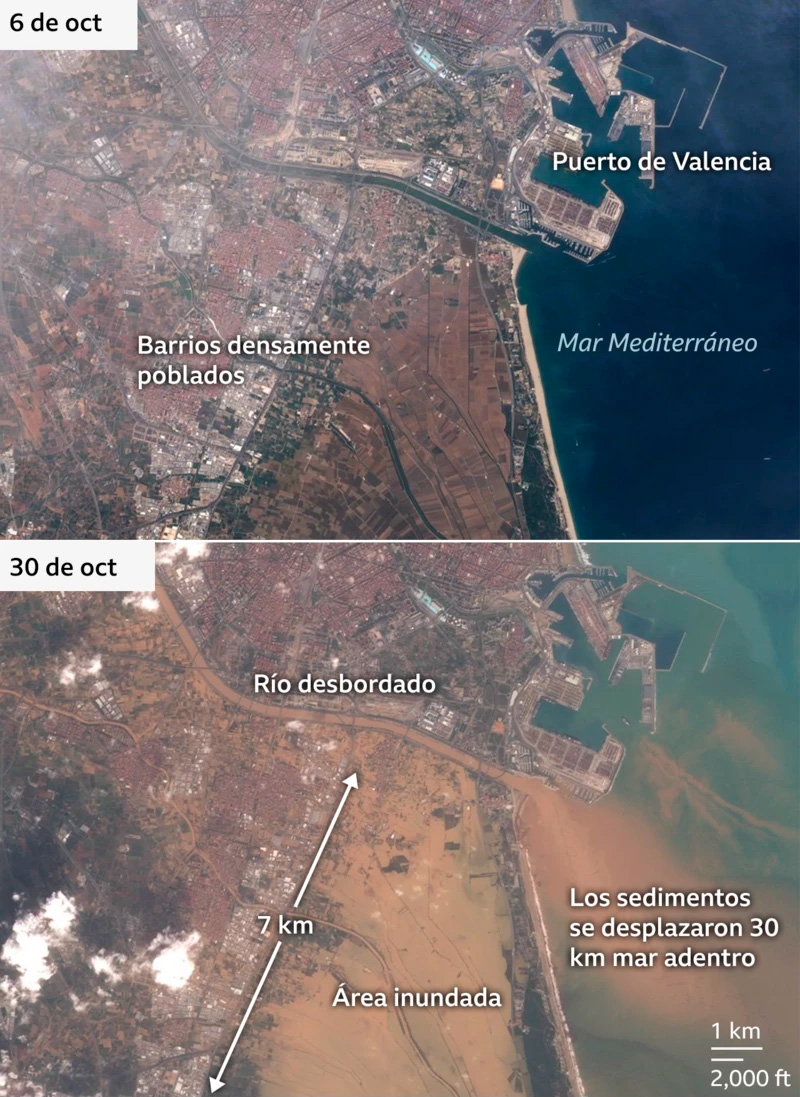 Global warming raises the temperature of the Mediterranean, allowing DANAs to be more intense. The World Weather Attribution organisation, which is dedicated to analysing the effects of climate change on extreme phenomena, estimates that torrential rains of this type are now 12% more intense and twice as likely compared to the pre-industrial climate. Friederike Otto, a researcher at Imperial College London, explains that “we are seeing events from the past, but they are becoming more common and extreme due to global warming.” This phenomenon in Valencia is an example of how climate change is already affecting communities and ecosystems, and emphasizes the need to take measures to prepare for an increasingly unpredictable climate.
Global warming raises the temperature of the Mediterranean, allowing DANAs to be more intense. The World Weather Attribution organisation, which is dedicated to analysing the effects of climate change on extreme phenomena, estimates that torrential rains of this type are now 12% more intense and twice as likely compared to the pre-industrial climate. Friederike Otto, a researcher at Imperial College London, explains that “we are seeing events from the past, but they are becoming more common and extreme due to global warming.” This phenomenon in Valencia is an example of how climate change is already affecting communities and ecosystems, and emphasizes the need to take measures to prepare for an increasingly unpredictable climate.
Document generated in 0 second